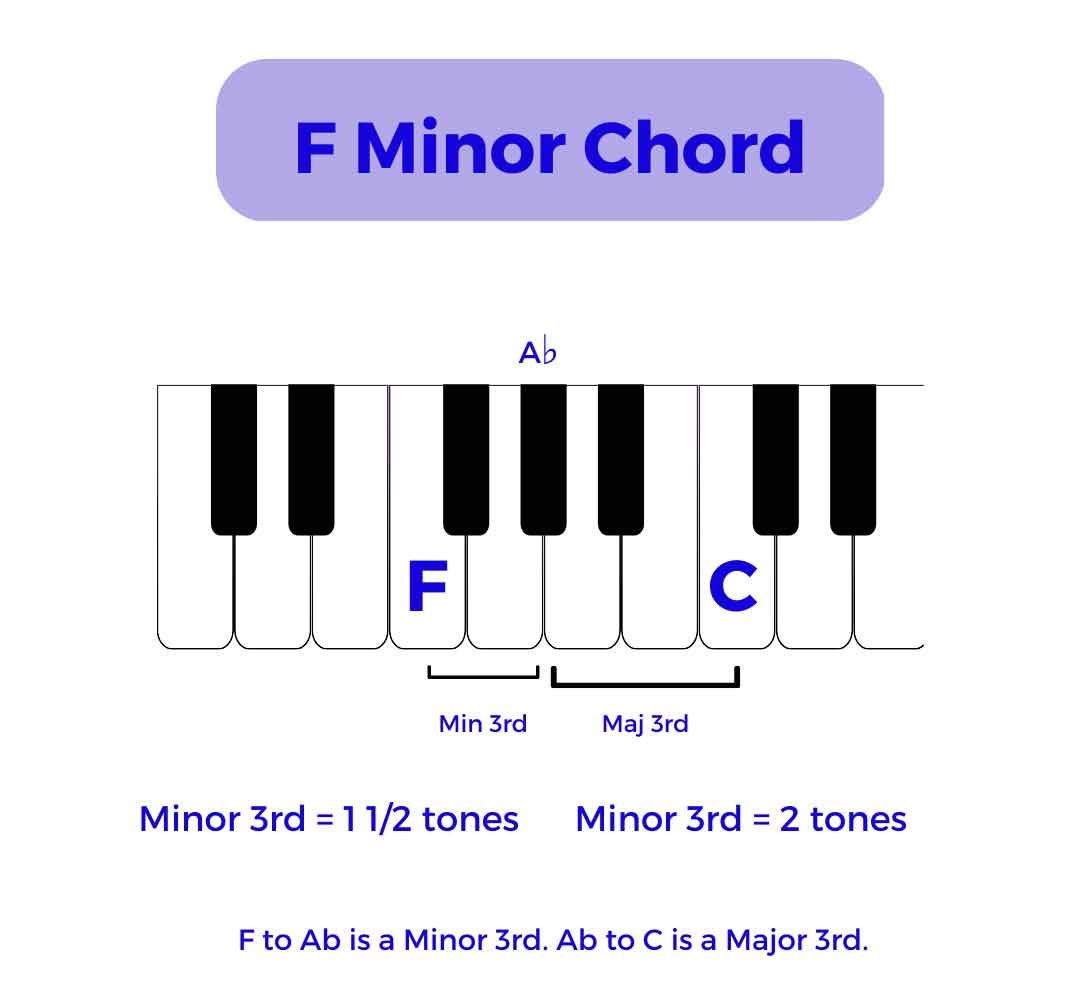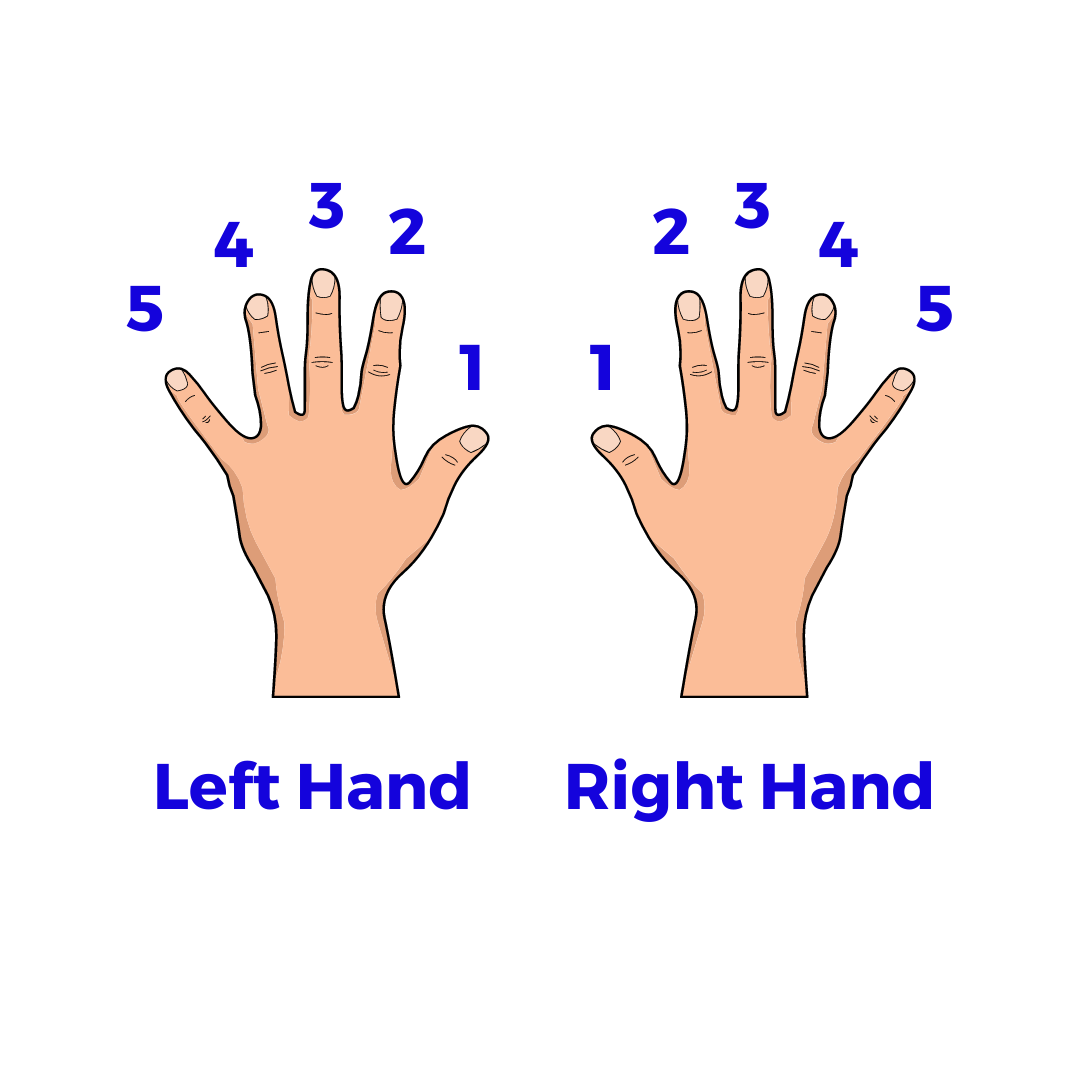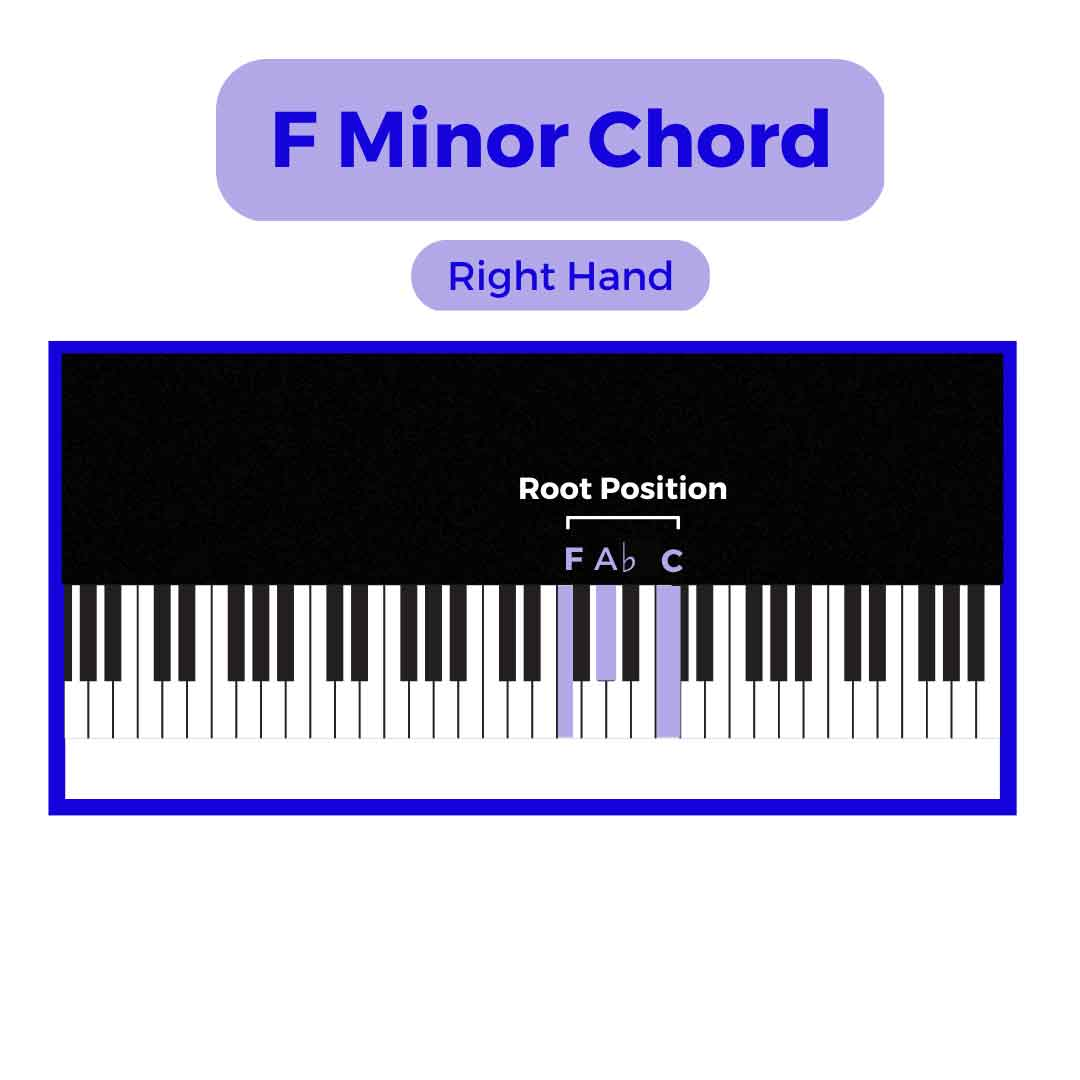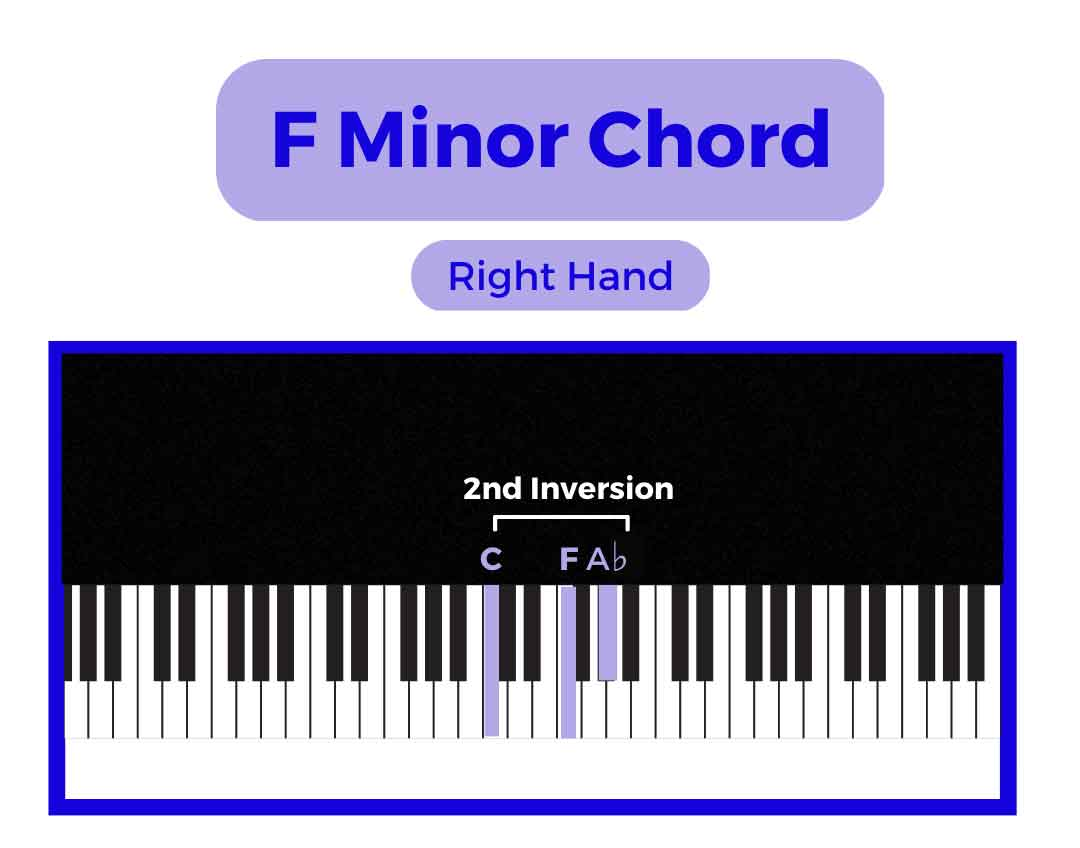The F minor piano chord is a beautiful, darker-sounding triad commonly found in many popular songs and classical pieces.
Mastering the F minor chord will broaden your repertoire of chords, deepen your understanding of music theory and harmony, and introduce you to new and exciting sounds.
If you're new to the world of piano, then learning about the Fm piano chord can seem daunting. Understanding hand and finger positioning for the chord can also be challenging.
But don't worry, as I'm here to help!
In this article, I'll explain how Fm (F minor) chord is built and how to play the Fm chord on a piano. I'll break down all the essential details, from fingerings to inversions, to help you play this basic piano chord with confidence and control.
So, let's get started!
What is an Fm Chord?
An Fm is a piano chord that consists of three notes: F, A♭, and C. The F is the root note, A♭ is the minor third, and C is the perfect fifth. This piano chord is also written as F minor, Fmin, or F – (F followed by a minus sign). "F-" is less commonly used.
The Fm chord is a minor triad, meaning it follows the intervallic formula of a minor third followed by a major third.
In other words, the distance between the root note (F) and the minor third (A♭) is three half steps or semitones, and the distance between the minor third and the perfect fifth (C) is four half steps or semitones.
Note: All minor chords (triads) follows the same intervallic formula of a minor third (three half steps) followed by a major third (four half steps).

A minor third interval is F to Ab, while a major third interval is Ab to C. In music, the minor third interval is three-half steps higher than a given note, while the major third interval is four-half steps higher than the note.
In terms of the scale degree formula, the Fm chord follows the pattern 1 – ♭3 – 5. The Fm triad is written as follows:
F – A♭ – C
That means the root note (F) is the first degree of the scale, the minor third (A♭) is the flat third degree of the scale, and the perfect fifth (C) is the fifth degree of the scale.
How to play Fm on the piano
You now know what the F minor piano chord is. In this section, I'll explain how to play F minor chord on a piano with the right hand and left hand.
But before we learn how this minor chord is played, let's quickly understand the Fm piano chord finger positions!
Fm Piano Chord Finger Positions
For starters, the fingers on each hand are numbered from 1 to 5.
The thumb is number 1, the index finger is 2, the middle finger is 3, the ring finger is 4, and the pinky finger (little finger) is 5. Remember these numbers as you position your fingers to play the chord.

In the root position of the F minor chord, the right-hand finger position is 1 – 3 – 5. The thumb (finger 1) plays the F note, the middle finger (finger 3) plays the Ab note, and the little finger (finger 5) plays the C note.
In the first inversion, the finger positions of the F minor chord are 1 – 2 – 5. That means the thumb plays Ab, the index finger (finger 2) plays C, and the pinky finger plays F.
In the second inversion, the fingering of the Fm piano chord is 1 – 3 – 5. That means your thumb plays C, the middle finger plays F, and the pinky finger plays Ab.
Playing the Fm Chord with the Right Hand
To play the Fm chord in the root position with your right hand, use the following fingers:
- F - First finger (1)
- A♭ - Third finger (3)
- C - Fifth finger (5)
To play the F minor chord with the right hand, place your thumb on F, the middle finger on Ab, and the pinky finger on C. At this point, the Fm chord is at its root position.
For the correct finger placements to play an F minor chord with the right hand, see the image below:

You'll hear the Fm piano chord when you press all three keys simultaneously.
Playing the Fm Chord with the Left Hand
To play the Fm chord in the root position with your left hand, use the following fingers:
- F - Fifth finger (5)
- A♭ - Third finger (3)
- C - First finger (1)

Put your pinky on F (bass note), middle finger on Ab, and thumb on C to play the F minor chord with the left hand. Once you have positioned your hand correctly on your piano keyboard, press down all three keys simultaneously.
Play this minor piano chord several times until you are comfortable with the fingering and sound.
The F minor chord has two inversions in addition to its root position. So, let's take a look at the first and second inversions of the Fm chord.
How to Play the First Inversion of the Fm Piano Chord
If you want to play the 1st Inversion of the Fm chord, lower the middle note (Ab). So, the Ab is the lowest note in the 1st inversion of F minor. Use the following fingers on your right hand to play the inversion:
- A♭ - First finger (1)
- C - Second finger (2)
- F - Fifth finger (5)

After placing your fingers correctly, press all the notes at once to play the first inversion of the piano chord. And then practice for a few minutes to get comfortable with it.
How to Play the Second Inversion of the Fm Piano Chord
If you want to play F minor in its 2nd inversion, put C as the bass note (lowest note). If you want to play the inversion with your right hand, use these fingers:
- C - First finger (1)
- F - Third finger (3)
- A♭ - Fifth finger (5)

Again, play these notes simultaneously and enjoy the sound of this piano chord in the second inversion.
FAQs
What Is The Difference Between A Minor Triad And A Major Triad?
Minor and major piano chords differ based on the interval between the notes that make up the chord.
A major chord (triad) consists of a root note, a major third, and a perfect fifth. The interval between the root note and the major third is four half steps or semitones, while the interval between the major third and the perfect fifth is three half steps or semitones.
On the other hand, a minor triad consists of a root note, a minor third, and a perfect fifth. The interval between the root note and the minor third is three half steps or semitones, while the interval between the minor third and the perfect fifth is four half steps or semitones.
In summary, a major triad and a minor triad are just the opposite of each other. A major triad is composed of a major third followed by a minor third, while a minor triad is composed of a minor third followed by a major third.
Can I Use F Minor Chord In Different Music Styles?
You can use the F minor chord (Fm) in various music styles. The key signature F Minor is one of the most common minor keys used in music composition.
It works well in slower, more emotionally charged songs because the Fm chord has a sad, reflective quality. However, you can also use it to add contrast and variety to more upbeat and energetic music. You can also use it in more upbeat and energetic music to add more contrast and variety.
The Fm chord is commonly used in flok, rock, and blues music styles. It is also popular in jazz, classical, and many other music styles.
Are There Any Songs That Use The Fm Chord On The Piano?
Yes, many songs use the Fm chord on the piano. Some examples include:
- "Bohemian Rhapsody" by Green Day
- "All of Me" by John Legend
- "Army" by Ben Folds Five
- "ET" by Katy Perry
- "Michelle" by The Beatles
- "Animals" by Martin Garrix
- "Halo" by Beyonce
- "First of the Year" by Skrillex
Conclusion
In conclusion, the Fm chord is a popular and valuable chord to know how to play on the piano. It is a minor chord consisting of the notes F, Ab, and C, and you can play it with either your right or left hand.
You can use the Fm chord in many types of music, and it adds depth and emotion to your playing.
Following the steps outlined in this blog post and practicing regularly, you can quickly and easily learn to play the Fm chord.
Whether you are a beginner or an experienced musician, it is worth the time and effort to master the Fm chord.
So, grab your best piano keyboard and practice the F minor piano chord!
Read More
Harlan Kilstein began playing piano during covid with no piano background at all. He taught himself how to play learning what to do and what not to do.
Today he's an advanced intermediate player and can help you grow in your skills because he learned all this on his own.








